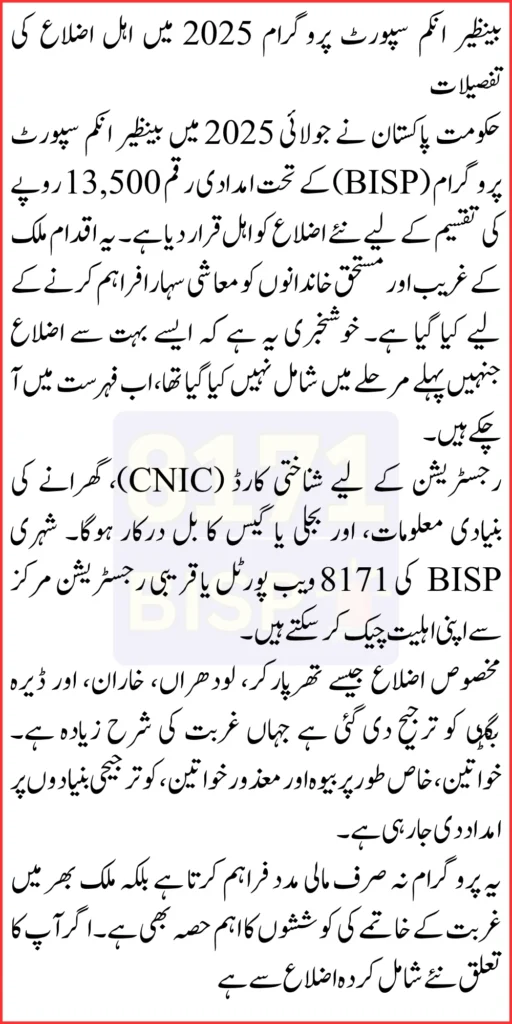The Benazir Income Support Programme (BISP) continues to be a vital lifeline for millions of low-income households across Pakistan. As of 2025, the program has expanded its reach and is now more region-specific, ensuring that support reaches the most deserving families in every eligible district. Understanding whether your district qualifies and how regional eligibility affects your chances of receiving benefits is more important than ever.
This updated guide will walk you through the latest BISP eligibility districts in 2025, highlight the expansion efforts, and explain how you can check your district’s inclusion in the program
Understanding BISP’s District-Wise Eligibility in 2025
BISP does not operate uniformly across every part of Pakistan. The government evaluates poverty data, socio-economic indicators, and NADRA records to decide which districts should be prioritized.
In 2025, the government has re-evaluated eligibility zones under the Benazir Kafalat Program and introduced new districts into the eligibility map while also focusing on better outreach and transparency.

Key Factors That Determine District Eligibility
- High poverty rates based on the National Socio-Economic Registry (NSER)
- Low female literacy and employment
- Underdeveloped or rural areas with limited access to banking
- Historical lack of inclusion in social welfare programs
Also Read About : Track Your July 2025 BISP Balance by CNIC – A Clear and Friendly Step-by-Step Guide
List of Provinces Covered and District Expansion
1. Punjab
Most districts in Punjab are eligible, but special attention has been given to:
- South Punjab regions like Dera Ghazi Khan, Rajanpur, and Bahawalnagar
- Remote tehsils in districts like Mianwali and Layyah
These areas show lower access to financial services and are now being prioritized.
2. Sindh
The BISP has expanded further into interior Sindh. Notable eligible districts in 2025 include:
- Tharparkar
- Sanghar
- Badin
- Jacobabad
- Kashmore
These regions were selected due to severe poverty levels and limited infrastructure.
3. Khyber Pakhtunkhwa (KP)
With the merger of tribal districts, KP now sees more inclusive coverage:
- Kurram
- Orakzai
- Bajaur
- Swat
- Bannu
The government has launched mobile registration vans in hilly and hard-to-reach areas.
4. Balochistan
Due to its vast geography and poverty indicators, BISP’s expansion in Balochistan is vital. Eligible districts include:
- Khuzdar
- Kech
- Kharan
- Sibi
- Zhob
Mobile banking units are being used to ensure smooth payment disbursements.
5. Gilgit-Baltistan & AJK
In 2025, BISP is making a stronger footprint in:
- Skardu
- Hunza
- Muzaffarabad
- Mirpur
These districts have been recently added to ensure equitable distribution.
Also Read About : BISP July 2025 Update: 3 Categories of Women Declared Ineligible for Rs.13,500 in Benazir Kafalat
How to Check If Your District Is Eligible
Step-by-Step Process:
- SMS Your CNIC to 8171
This is the fastest method. If your district is eligible and you qualify, you will receive confirmation. - Visit the Nearest BISP Office
BISP Tehsil offices have updated district-wise lists and NSER data. - Use the Online BISP Portal
Log on to the official 8171.bisp.gov.pk portal, enter your CNIC, and check your status. - Mobile Registration Vans
New mobile units are also visiting remote and underdeveloped districts to assist families with registration and district confirmation.
Also Read About : Transgender Rights and BISP July 2025 Update: A New Chapter of Inclusion and Equality in Pakistan
Why District-Based Eligibility Matters
Knowing your district’s status is not just about location — it reflects the availability of services, financial inclusion, and overall access to government support. It’s essential for residents to stay informed, especially in newly added districts, so they don’t miss the opportunity for registration and financial aid.
Also Read About : BISP and Girls’ Education in 2025: How Cash Transfers Are Boosting School Attendance
Final Thought
As Pakistan continues to modernize and digitize its social safety nets, the Benazir Income Support Programme in 2025 is placing increased focus on regional equity. Understanding whether your district is on the eligibility list is the first step toward financial relief and support.
If you live in a newly added or previously underserved district, act now. Check your status, register if needed, and make sure those around you — especially women and vulnerable families — are informed as well. In times of rising economic pressures, every rupee of support counts, and BISP is working to ensure no deserving household is left behind.
Frequently Asked Questions (FAQs)
1. How can I confirm if my district is eligible for BISP in 2025?
Send your CNIC number to 8171 via SMS or visit the official 8171 web portal to check district eligibility and personal status.
2. Has BISP expanded to new districts in 2025?
Yes, many rural and tribal districts in KP, Balochistan, and interior Sindh have been added this year to ensure better inclusion.
3. What if my district is not currently eligible?
District eligibility is updated periodically. You should still register through NSER, and your status may change based on new surveys or reforms.
4. Is district eligibility the same for all BISP programs like Taleemi Wazaif and Kafalat?
No, some sub-programs may have specific coverage zones. Always check with your local BISP office for program-specific eligibility.
5. Can residents of big cities like Lahore or Karachi also qualify for BISP?
Yes, but only if they meet the poverty and need-based criteria. Eligibility is not limited to rural areas, but urban poor families must still register through NSER.
Also Read About : How BISP Is Combating Hunger and Improving Nutrition in Pakistan – A 2025 Guide to Food Security

